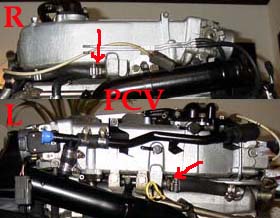General:
This part describes further investigation on unstable idle problems.
Main topics are Coolant Temp sensor, TPS, Power balance test, IgnitionCoils, Spark plugs, Injectors, CAS, MAS, Fuel delivery, PCVs, vacuum leaksand compression test.
Coolant temperature sensor:
The ECU coolant temp sensor is a very common cause of high idle, hesitation
and safety boost mode.
It's located in front of the engine on the upper aluminium coolantpipe (see
pic 1).
Most often the source of the problem is bad connection caused by corrosion
on its contact (see Connector
Cleaning document for the cleaning procedure).
You can also check the resistance of the sensor by measuring it acrossits
terminals.
The resistance should be:
2.1-2.9 kOhm at 20C (68F)
0.68-1.0 kOhm at 50C (122F)
0.30-0.33 kOhm at 80C (176F)
TPS - Throttle Position Sensor:
Poorly adjusted TPS can cause jumping or high idle. The TPS is locatedon
the left throttle body, pic 2.
To measure its output voltage (if you haven't got a AVC-R or AFC ora Techtom
MDM-100) you have to insert a thin wire in its harness contact(pic 2), since
it has to be connected while measuring.
Measure between the middle pin and the chassis or battery ground.
The voltage should be between 0.4V and 0.45V (the spec says 0.5V butthat's
to high from my experience).
To adjust the voltage, turn ignition switch ON, loosen the screws holding
the TPS and turn it slightly (CW => -) until the voltage is within spec.
Tighten the screws and recheck voltage.
Open the throttle fully and check that the output voltage is ~4V.
Important: If you haven't cleaned the throttle bodies, do it first (seePart1) and then adjust the TPS.
A worn out TPS can cause problems like: jumping RPM while driving
andshifting problems with auto transmission.
A new TPS costs ~$29. Check the part number
HEREstarting at page 2-A-8, section Throttle Chamber.
Power Balance test:
If the engine is missing at idle, try to determine if the problem isconnected
to one of the cylinders.
Start the engine and proceed to disconnect each of the coil connectors(pic
3), one at a time. The idle should drop when disconnecting a coil.If the
idle doesn't change at all or changes only slightly compared toother cylinders
then you've narrowed the problem to a single cylinder.
Ignition Coils:
Easiest way of checking a coil is to swap it with another good one.
If you discovered one faulty cylinder in the power balance test thenswap
the suspected coil with a coil from a cylinder that was firing correctly.
Perform the power balance test again and see if the problem moves together
with the coil. If yes then replace the coil.
You can also check the resistance between the middle and the left pin(looking from the side of the engine) of the coil connector. It should be ~0.7 Ohm.
Check also the coil connectors for corrosion and overall condition.
The locking pin tends to brake and the connector can come off by itself.
See Contact cleaningdocument
for more info on repairing the harness.
Spark plugs:
Examine all the spark plugs carefully cause they've got a lot to "tell".
Be sure to know which one comes from which cylinder. If you installedspark
plugs that are to cold then they could foul and contribute to anunstable
idle. Use the colder PFR6B-11B plugs on a modded Z. Going onegrade colder
to PFR7B-11 is only necessary when pushing SERIOUS power whileracing. The
standard gap is 1.1mm. The gap should be lowered on modifiedengines. I'm
running on ~0.8mm gap.
Compare all the spark plugs to see if you've got a problem with oneof the
cylinders. If one spark plug is abnormally fouled that could meanthat one
injector is leaking. If there is an oil leak in the system (e.g.from a turbo)
then you would see some burned oil residue on the plug.
A normal plug will be clean with white or tan insulator. See
www.ngksparkplugs.comfor more info on plugs.
Injectors:
Injectors themselves are hard to diagnose. Like mentioned above, aleaking
injector could be diagnosed by looking at the spark plug. Thereis also one
more hint that I've heard of. If you let the car sit for acouple of hours
and then remove the plug then you would smell a strongfuel smell from the
cylinder that has a leaking injector and the plug wouldprobably be wet with
fuel.
You can also examine if the injector is "ticking" if you let the caridle
and put a long screwdriver on the top of the injector while puttingyour ear
to the handle. You should hear a loud clicking. Compare the soundfrom all
the injectors. If an injector is not clicking then it's dead.
You can check the resistance of the injectors as well by measuringit across
its terminals. It should be between 10 and 14 Ohm.
Most often though, the problem is caused by corroded injector connectors.
They are accessible from the top of the plenum (pic 4). If they are broken
or in a really bad shape then I would recommend that you replace them.
You can use two sets of injector connectors PN: 24079-25P26 (~$20).They are
meant for a Z from the 80's but they'll fit, well almost... Youwill have
to knock off a plastic pin on the injector connector, not to difficult.See
the Connector Cleaningdocument
for more info on this.
CAS:
The Crank Angle Sensor informs the ECU about the current position ofthe crank
shaft (pic 5).
The most common reason for it affecting the idle is the connector getting
dirty, although if the CAS connection is completely broken the car won'tstart
at all. The best way to examine CAS is to pull it out completely.Be sure
to mark its position so you can reinstall it like it was before(use millimetre
precision here).
Clean the connector if required. Check also that the sensor is spinningfreely
without the
bearings making to much noise and vibrations.
Check that the half circle pin inside its shaft is intact. Some earlymodel
Zs had wrongly machined heads causing the pin to wear out.
The ECU will not always report an error on the CAS. I had to put theECU in test mode and then crank the engine before the CAS-fault code showed up.
MAS:
Mass Airflow Sensor (pic 6) tells the ECU how much air is enteringthe engine
which in turn gives the information about how much fuel needsto be supplied.
Check the MAS by looking through it to see if the hot-wire is damaged
or clogged by dirt. You can gently clean the hot-wire by spraying it with
a contact cleaner that doesn't leave a protective film. I cleaned minewith
brake cleaner since it evaporates completely but it could be a littleharsh
for the vulnerable hot wire..
Never remove the mash screen! It serves both as a protection and hasits effect
on the airflow.
You can check the MAS voltage at the ECU (see
ECUcontact diagram) with a volt meter.
It should read ~0.8V with ignition on (some people get 0.08V on theTechtom)
and ~1.5V at idle, unless you've got a vacuum leak somewhere...
Vacuum leaks:
Basically examine all of the hoses for leaks. If there is a vacuumleak somewhere
then air that's not registered by MAS will enter the systemcausing the engine
to run to lean.
See the Finding Vacuum Leaks
article for more info.
.
Fuel delivery:
Check the fuel pressure after the fuel filter.
Depressurize the fuel system by disconnecting the fuel pump under thespare
tire or disconnecting the
fuel pump relay (see pic 7). Start the engine and let it stall.Crank
it again a couple of times to let more fuel out.
There's always a bit of pressure left in the hoses so have some ragshandy.
Disconnect the fuel filter hose from the metal pipe on the plenum.Insert
a T-pipe there (pic 8). Attach a pressure gauge to the T and tightenall clamps.
Now reconnect the fuel pump harness and pressurize the system by turningthe
ignition key 3 times ON and OFF (the fuel pump operates for a secondor two
after ignition on, you should be able to hear it).
Check for leaks and start the engine.
The fuel pressure at idle should be approximately 2.5bar (36 psi)
The fuel pressure should rise with the pressure in the intake manifold.
Disconnect the vacuum line from the pressure regulator (pic 9) andthe fuel
pressure should rise to ~3 bar (~43.4 psi)
PCV-valves:
The Positive Crankcase Ventilation valves are located under the plenumon
its right and left side (see pic 10)
Faulty PCVs can cause crank case air to be sucked in to the plenumat times
when it's not supposed to.
They can also get stuck closed so that excessive pressure is builtup inside
the crank case causing the engine oil to leak
through the rear main seal and sometimes the oil dipstick to pop out.
There is also one more symptom that happened to me. The spring insidethe
PCVs got weak so they opened wile braking and
that caused the engine to stall after a fairly hard braking.
I would recommend everyone with an older Z to replace them. They cost~$3.4
so it's not a big deal (PN 11810-40P00).
Be sure to get new rubber hoses since the old ones are probably hardas a
rock and you have to cut them.
The part numbers are 11826-30P11 for the left one and 11826-30P01 forthe
right one (~$23 total).
Remove the battery while replacing the PCV on passenger side.
Do not over torque them when installing, you can brake the plenum!!
Compression test:
Always a good way to see the condition of the engine internals, especially
if you find that there is a problem with a
particular cylinder when looking at its spark plug.
Below is the procedure as described in the Service Manual (except forthe
fusible link).
- Warm up the engine
- Turn ignition switch off
- Disconnect the fusible link (by the battery) named "Fuel pump, Inj."
- Remove all spark plugs
- Attach compression tester to no. 1 cylinder
- Depress accelerator pedal fully to keep the throttle bodies wide open.
- Crank engine and record the highest gauge indication
- Repeat the measurement for each cylinder.
Compression pressure:
- Standard: 12,85 bar (186 psi) for NA ; 11,79 bar (171 psi) for TT
- Minimum: 9,81 bar (142 psi) for NA ; 8,83 bar (128 psi) for TT
- Maximum difference between cylinders: 0,98 bar (14 psi)
- If adding oil helps compression, piston rings may be worn or damaged. Replacepiston rings after checking the piston for damage.
- If pressure stays low, a valve may be sticking or seating improperly. Inspectand repair the valves and their seats.
- If compression in any two adjacent cylinders is low and if adding oil doesnot help, there may be a leakage past head gasket surface.
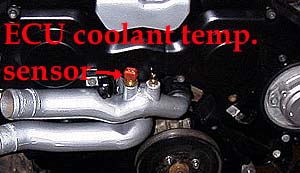
2.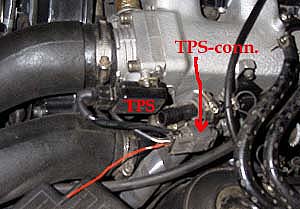
3.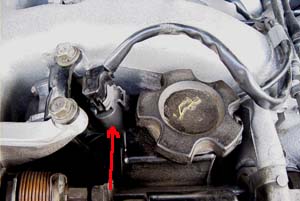
4.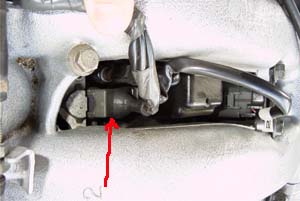
5.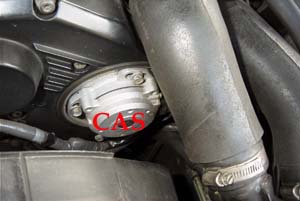
6.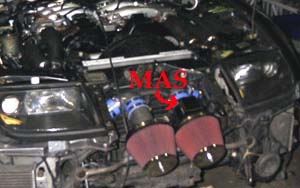
7.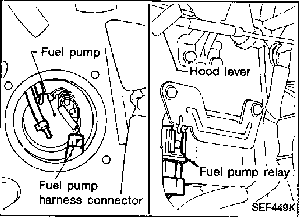
8.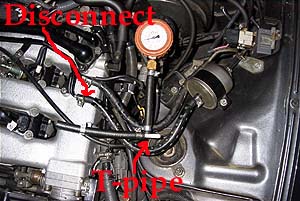
9.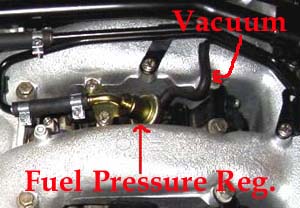
10.